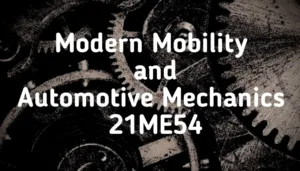
Modern Mobility and Automotive Mechanics 21ME54
Module 1`
History of Automobile, Classification of Automobile w.r.t Usage, Chassis, Body, Power Sources, capacity, main
components of Internal Combustion Engines and their Functions, Fuel supply system, Cooling System, Lubrication
System & Ignition System, Engine Management System, super charged engines, hybrid engines, modern GT engines
Module 2
Clutches; Plate Clutches, Cone Clutch, Centrifugal Clutch, Fluid Flywheel
Gear Box; Gear Shifting mechanism, synchromesh Gear box, Torque converter, Automatic Manual Transmission
(AMT), Automatic Transmission (AT), intelligent manual Transmission (IMT) Continuously Variable Transmission (CVT),
Infinitely Variable Transmission (IVT)- Working of Differential, Rear Axle types &construction.
Suspension – layout & working of Hydraulic& Air suspension, Independent suspension, Functions& advantages of Leaf
Spring, Coil Spring, Telescopic Shock Absorber, Torsion Bar
Module 3
Steering system- mechanisms & Linkages, Steering gear boxes- Rack & pinion, worm & wheel construction &
working,, power Steering construction & working, steering geometry, Wheel balancing
Braking System- Mechanism and Linkages; Mechanical Brakes, Hydraulic Brakes, Power Brakes, Parking brakes, ABS,
Safety system – Safety measures in modern vehicle – safety frames – working of – air bags, seat belt, collapsible
steering, spoilers, defoggers, fire safety measures in heavy vehicles, bullet proof vehicles
Module 4
Exhaust gas pollutants and their effects on environment, Emission norms, IC engine fuels types, extraction& availability,
BIO Fuels – Production and impact. Ethanol engines, CNG vehicles- operation, advantages& disadvantages, over view of
Hydrogen – fuel cell vehicles, advantages & disadvantages, IC engine/ electric hybrid vehicles over view, layout,
transmission & control system, solar powered vehicles- wind powered vehicles, super capacitors, supply rails
Module 5
Electric vehicles principle and components- layout of two & 4 wheeler, Motors used in Electric vehicles –types- over
view of construction and working, power transmission & control system in Electric vehicles. Batteries –construction &
working principle of Lead acid, nickel based, sodium based, Lithium & Metal Air batteries. Battery charging types and
requirements, battery cooling, fire safety measures in EV vehicles
Hi my family member! I want to say that this article is awesome, great written and come with approximately
all important infos. I woul like to see extra posts like
this . https://Odessaforum.Biz.ua/